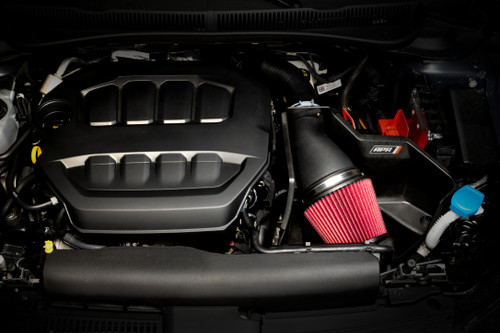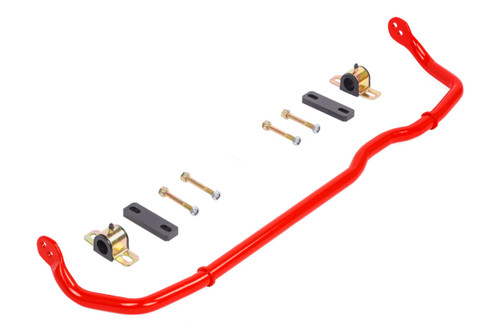 WARNING: This product can expose you to chemicals that are known to the State of California to cause cancer, birth defects or other reproductive harm. For more information, visit www.P65warnings.ca.gov.
WARNING: This product can expose you to chemicals that are known to the State of California to cause cancer, birth defects or other reproductive harm. For more information, visit www.P65warnings.ca.gov.The APR EFR7163 Turbocharger System produces up to 53 HP and lays down 10-second quarter mile passes, all through a convenient and affordable, turn-key solution. It represents a threat to the establishment of turbo four cylinder vehicles of yesteryear, and breaks the hearts of muscle cars and exotics everywhere as they are left in the dust by an engine a third the size of theirs, screaming a turbocharged battle cry as it passes. It is a vicious beast, yet a beast easy to tame. It makes for a civilized daily driver that quietly sips premium fuel with surprisingly excellent mileage. Deceivingly quick transient response, with near stock-like turbo lag makes for an experience devoid of the compromises many would expect from an engine this size. It is the answer to the desire for more power, and it's the brainchild of APR's talented engineering teams, with over a year and a half of initial development, and a never ending drive for perfection. It is easy to install, blisteringly fast, and produces an absolutely exhilarating driving experience!
Quick Facts
Product Note
The APR'stage III+ Turbocharger Systems are designed for use with several other modifications. APR'strongly advises rebuilding the engine, especially at the maximum power levels. APR'strives to engineer the most comprehensive solutions on the market, including validation of APR products and claims through extensive research and development. To receive the best service and support, and to experience and achieve the product's advertised results, it is imperative to only use APR certified products as results may otherwise vary. Proper maintenance, operation and a quality install is necessary under all scenarios. Please view our requirements and recommendations in the tabs below.Stage 3 Requirements- Fueling
The APR HPFP is required. The APR LPFP is required for the higher output LPFP software.Stage 3 Requirements Exhaust
The APR AWD Midpipe is required if the vehicle is not already equipped with an APR downpipe.Stage 3 Requirements-Intake
The APR Carbon Fiber Intake System is recommended and required to meet the advertised power levels (R/S3 platform).Stage 3 requirements- Intercooler
The APR Intercooler System is recommended and required to meet the advertised power levels.Stage 3 requirements- Transmission
APR cannot make any guarantees as to the longevity of the OEM manual transmission clutch or DSG/S Tronic clutches in every transmission and therefore an upgraded clutch, such as APR's upcoming DSG Clutch Packs, are recommended and may be required depending on the stage, octane, driving style and clutch health. APR's Stage III DQ250 TCU Upgrade is required for DSG / S Tronic models.Stage 3 requirements- Engine Interval
Stage III power, torque, boost, cylinder pressure and temperature levels and more are substantially higher than stock. APR cannot make any guarantees as to the longevity of the factory engine internals or all factory components on every engine. As such, APR recommends upgrading rods/bearings and pistons/rings for increased engine reliability and longevity, especially when using race fuel.Stage 3 requirements- Spark Plugs
NGK BKR8EIX, gapped to 0.022" ?0.002' or 0.55mm ?0.05mm with a change interval of 10-15,000 mi or 16-24,000 km spark plugs are included and required.Stage 3 Requirements- Oil and Coolant
APR recommends using Motul oils, coolants and lubricants. APR strongly recommends an ester based oil, such as Motul 30V.Engine Management
Included with the turbocharger system is APR's world-renowned Stage III+ ECU Upgrade! This software upgrade installs on the factory ECU and requires no extra end user configuration or tuning and eliminates the need for costly piggyback controlling devices. Simply visit any APR dealer and the software installs in minutes!
APR's Engineers spent more than a year and a half researching and developing the factory engine management system to operate seamlessly with the extensive changes introduced at Stage III+. This includes thousands of full power sweeps on the engine and chassis dynos, street and track. This was no simple task as power is well beyond the original configuration with extensive hardware changes. Through both ECU's ource code and calibration changes, APR's Engineers converted the system to run with a substantially larger turbocharger, featuring a pneumatic wastegate actuator and larger MAP sensors. At Stage III+ power levels, the software supports larger port injectors and a larger fuel pump.
To better understand the complexity of the engine management system, one must first understand the models within. The factory engine management system uses modeled, or simulated input, to control the engine without the need for costly sensors. While some sensors are still used, the ECU does not measure how fast the turbocharger is spinning, temperature of the exhaust gasses, or how much backpressure is in the turbine housing, among many other important things. When developing the factory calibration, sensors were used to measure each of these items and then models were made within the ECU and the sensors were removed. The ECU then relies heavily on expected behavior from factory components. However, if these components are altered, such as changing the turbocharger, the models no longer work and the engine no longer runs correctly. This is why properly created Stage III+ software is so critical.
To properly configure the ECU, APR's engineers spent months updating the ECU's modeled information to the new hardware specifications. While on the engine dyno, various expensive and sensitive probes were installed throughout the engine allowing APR's engineers to measure and alter critical information within the ECU. When hardware changes were necessary, APR's Mechanical Engineers were able to make changes, rather than requiring the calibrators to tune around the shortcomings. APR's incredibly powerful and proprietary ECUx data logging suite allowed APR's engineers to monitor every change within the ECU at extremely high resolution, ultimately resulting in a calibration that is responsibly created. The ECU fully understands the changes Stage III+ brings, and as such, can properly manage and control the engine. Because of this, APR's Engineers can aggressively seek exciting power levels without taking risky shortcuts. The engine operates more smoothly, enhancing everything from daily driving to full-on acceleration. Fuel economy is better and the ECU can properly protect the engine from dangerous operating conditions. To APR's Engineers, it's responsible tuning. To the driver, it just works.
TurboCharger and Wastegate
Response, top end power, and reliability were all at the forefront of the Stage III+ turbocharger'selection. Typically, these features do not go hand-in-hand. Larger turbos tend to be laggy, while small, responsive turbos lack top-end power. However, the Borg Warner EFR7163 has broken the mold. Featuring the latest advancements in technology, combined with APR's advance tuning strategies, the ultimate in performance and reliability has been achieved!
Power:
The EFR7163 features a massive, 71mm forged-billet compressor wheel capable of outflowing the competition due in part to its extended-tip compressor geometry. By providing up to 60 lb/min in airflow, the turbocharger is capable of producing massive power and provides headroom for increasing output with future modifications.
Response:
To spin the massive compressor wheel quickly, the EFR7163 features a lightweight turbine wheel made from titanium aluminide, or Gamma-Ti, and feature new Mixed-Flow geometry. At nearly half the weight of conventional turbine wheels, the difference is extremely noticeable as transient response is lightning-fast upon smashing the accelerator! To further aid in low-end response without sacrificing top-end power, APR's engineers built Stage III around the EFR's optional T4 divided twin scroll turbine housing. This stainless steel housing is internally gated, making it the perfect solution for this application.
Reliability:
With reliability also at the forefront of APR's engineering design criteria, the EFR continued to shine as the clear choice. APR chose the optional aluminum center section, which houses the EFR's massive ceramic ball bearing housing. Unlike traditional housings, and journal bearings as found on the OEM IHI turbocharger, the bearing arrangement provides a large thrust-load capacity, and thus reliability, over other setups. Friction is reduced, turbocharger response is enhanced, and oil blow-by resistance is greatly improved, making the EFR an extremely reliable solution.
Integrated Equipment:
The EFR7163 features an integrated recirculation port for mounting the factory diverter valve (DV), boost control solenoid (N75) and wastegate actuator, all of which ultimately reduces complexity of the install, and reduces engine bay clutter. Furthermore, APR's engineers integrated a stainless steel heat shield onto the turbocharger, to protect surrounding components. Each unit comes assembled and clocked, with the wastegate preload set, measured and tested, to ensure the unit'simply bolts on without any modification necessary.Wastegate:
The factory electronic wastegate can become problematic at higher output levels. The unit's electronics are sensitive to heat, and the plastic gears within can strip and fail while struggling and failing to hold and control boost pressure. In the event of failure, replacements are typically only readily available by purchasing a new OEM turbo, making for a costly scenario. APR's engineers upgraded the wastegate with an APR by TurboSmart pneumatic wastegate. The unit is capable of accurately controlling and holding higher boost pressure levels without prematurely cracking open, or overheating under prolonged use. The unit'simply comes assembled, configured and installed on the turbo, ready for use!
- PDP tag:
- Free Shipping*












